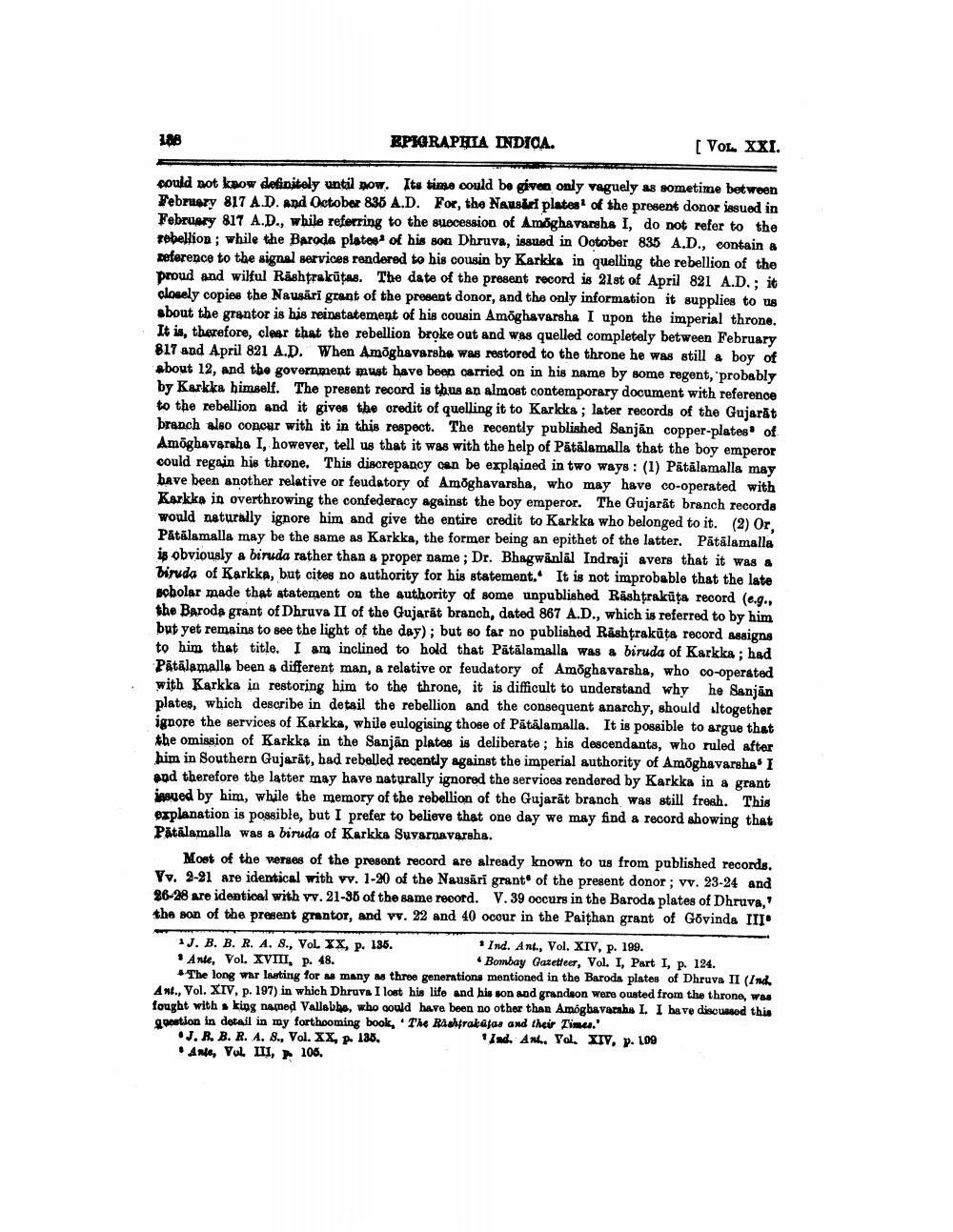________________
16
BPKGRAPHIA INDICA.
[VOL XXI.
could not know definitely until now. Its time could be given only vaguely as sometime between February 817 A.D. and October 838 A.D. For, the Nausic plates of the present donor issued in February 817 A.D., while referring to the suecession of Amöghavarsha I, do not refer to the rebellion; while the Baroda platest of his son Dhruva, issued in October 835 A.D., contain a Reference to the signal services rendered to his cousin by Karkka in quelling the rebellion of the proud and wilful Rashtrakūtas. The date of the present record is 21st of April 821 A.D.; it closely copies the Nausäri grant of the present donor, and the only information it supplies to as about the grantor is his reinstatement of his cousin Amöghavarsha I upon the imperial throne. It is therefore, clear that the rebellion broke out and was quelled completely between February 817 and April 821 A.D. When Amõghavarshe was restored to the throne he was still a boy of about 12, and the government must have been carried on in his name by some regent, probably by Karkka himself. The present record is thus an almost contemporary document with reference to the rebellion and it gives the credit of quelling it to Karkka ; later records of the Gujarat branch also concur with it in this respect. The recently published Sanjän copper-plates of Amõghavarsha I, however, tell us that it was with the help of Pātālamalla that the boy emperor could regain his throne. This discrepancy can be explained in two ways: (1) Pätālamalla may bave been another relative or feudatory of Amoghavarsha, who may have co-operated with Karkka in overthrowing the confederacy against the boy emperor. The Gujarāt branch records would naturally ignore him and give the entire credit to Karkka who belonged to it. (2) Or. Pätilamalla may be the same as Karkka, the former being an epithet of the latter. Pātālamalla is obviously a biruda rather than & proper name ; Dr. Bhagwanlal Indraji avers that it was a Biruda of Karkka, but cites no authority for his statement. It is not improbable that the late scholar made that statement on the authority of some unpublished Rashtrakūta record (e.g., the Baroda grant of Dhruva II of the Gujarat branch, dated 867 A.D., which is referred to by him but yet remains to see the light of the day); but so far no published Rashtrakūta record assigns to him that title. I am inclined to hold that Pätälamalla was a biruda of Karkka; had Pātālamalle been a different man, a relative or feudatory of Amoghavarsha, who co-operated with Karkka in restoring him to the throne, it is difficult to understand why he Sanjan plates, which describe in detail the rebellion and the consequent anarchy, should altogether ignore the services of Karkka, while eulogising those of Pätälamalla. It is possible to argue that the omission of Karkka in the Sanjān plates is deliberate ; his descendants, who ruled after him in Southern Gujarat, had rebelled recently against the imperial authority of Amõghavarsha' I and therefore the latter may have naturally ignored the services rendered by Karkka in a grant issued by him, while the memory of the rebellion of the Gujarāt branch was still fresh. This explanation is possible, but I prefer to believe that one day we may find a record showing that Påtalamalla was a biruda of Karkka Suvarnavarsha.
Most of the verses of the present record are already known to us from published records. Tv. 2-21 are identical with vv. 1-20 of the Nausāri grant of the present donor ; vv. 23-24 and 26-28 are identical with vv. 21-96 of the same record. V. 39 oocurs in the Baroda plates of Dhruva, the son of the present grantor, and vv. 22 and 40 ocour in the Paithan grant of Govinda III
1J. B. B. R. A. 8., VoL XX, p. 135.
Ind. Ant., Vol. XIV, p. 199. Ante, Vol. XVIII, p. 48.
Bombay Gazetteet, Vol. I, Part I, p. 124. The long war lasting for as many as three generations mentioned in the Baroda plates of Dhruva II (Ind. Ant., Vol. XIV, p. 197) in which Dhruva I lost his life and his son and grandeon were ouated from the throne, was fought with king named Vallabbe, who could have been no other than Amoghavarahs I. I have disowned this question in detail in my forthooming book, the Rashtrakas and their Tim . .J. R. B. R. A. 8., Vol. XX, p. 138.
I AM. Xa XIV, P. 109 • Anle, Vol II, 106.




